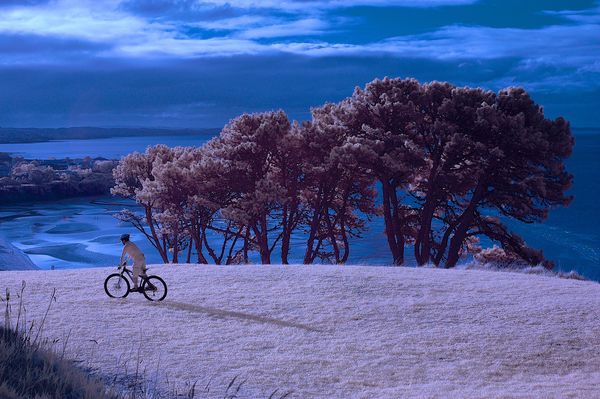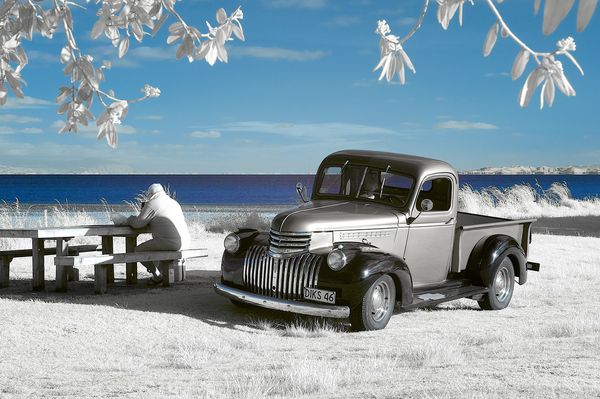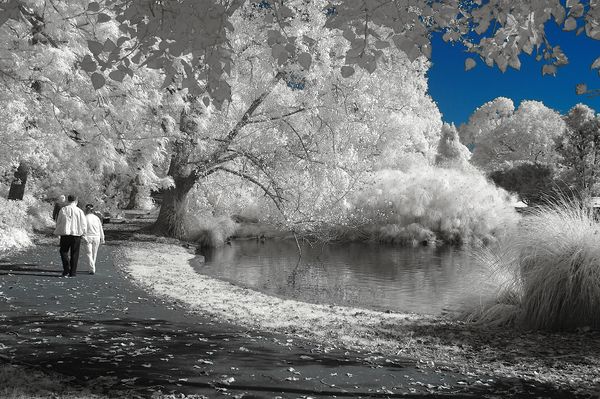Infrared 590nm 665nm or 720nm
Dec 9, 2014 04:31:05 #
I have a Nikon D70s converted to 590nm and have loved the results. I like it because you can mimic the others by desaturation etc but harder to go the other way with the 665 and 720nm. I am going to get my Nikon D2x converted as I want a higher resolution and better ergonomic camera with IR over the old D70s and the camera is just sitting in the cupboard doing nothing. My dilemma is which conversion should I do this time. Ive seen some spectacular images with the 720nm and even some quite saturated images with it. The whites are whiter than the other spectrums. What do other IR photographers have and why? I know I can get the whites pretty white with the 590nm especially if its shot in the bright sun. I guess its a case of settling for a bit less "white"or purer white but less colour.
Dec 9, 2014 04:41:09 #
Here are some of my images done with the 590nm showing whites and saturated colour..
Dec 9, 2014 04:54:17 #
I think if I go for the 720nm for the purer whites Im afraid of being disappointed with the lack of colour that i can play with! What do others think?



Dec 10, 2014 12:01:10 #
NikonDad
Loc: Bothell, WA
What do I think?
I think those are BEAUTIFUL images!!
Can you get better?
Amazing.
I think those are BEAUTIFUL images!!
Can you get better?
Amazing.
Dec 10, 2014 15:30:57 #
NikonDad wrote:
What do I think?
I think those are BEAUTIFUL images!!
Can you get better?
Amazing.
I think those are BEAUTIFUL images!!
Can you get better?
Amazing.
Thanks a lot, Im trying to get opinions on what other people think, if I took the same images with 665nm or 720nm what would the whites be like and the color? The big decision for me is to what version of conversion I will do on my camera I want to get converted to IR. Im hoping fellow hogs can put up some examples or some comments on what they think!..cheers
Dec 10, 2014 16:35:41 #
Why not convert to full spectrum and then you are free to pick which ever filter you are in the mood for. That is what I have. And you are not limited to 590nm then. You can go up shorter wavelength filters of orange and yellow for other effects. If you are shooting with B&W in mind, the effect is milder than the 590nm. I also have a filter to cut off UV and IR to make the camera use only the visible spectrum, but you have to be very careful with white balance to get the results you are expecting.
Dec 10, 2014 22:50:04 #
wdross
Loc: Castle Rock, Colorado
JimH123 wrote:
Why not convert to full spectrum and then you are ... (show quote)
JimH123 may have the best answer. Since most human vision is ~400 to 700, 720 is the only frequency that is just beyond human vision. That will make any green leaf color very white in IR black and white photography (green leaves reflect a lot of high end red and IR).
Dec 11, 2014 00:54:51 #
JimH123 wrote:
Why not convert to full spectrum and then you are ... (show quote)
By going full spectrum do you need to use filters on the front? which if the case I don't really want to bother with its just another cost as well. Thats why I chose the 590 because of its ability to mimic 665 and 720 but wondering if any out there know if the whites are as clean as the 720. Any images with 590 or 665 with very white foliage you can put up? I know some of my images here have pretty white foliage but how white would they be with the 720nm?. I guess the more pp the more noise as well!.cheers
Dec 11, 2014 01:41:00 #
wdross
Loc: Castle Rock, Colorado
saxkiwi wrote:
By going full spectrum do you need to use filters ... (show quote)
It comes down to what needs to be captured and what spectrum is being reflected in the scene. I do not have proof, but I suspect, based on what I have read about IR photography, you will have a higher dynamic range by cutting off everything below 700. That means your whites can be whiter while holding the same black or you can hold your whites while making your blacks even blacker. This is mainly because of how IR is reflected by what we see as a normal scene.
This, of course, changes when the scene either reflects very little IR or extreme amounts of IR. This is why morning glories were so hard to record with color film. Our eyes would cut off the IR being reflect by the morning glories while the film would see some of the IR and always very slightly "magentazise" the blue of the morning glory. By putting on an IR filter, the morning glory blue could be kept "true" blue.
Since your pictures look great, I think you may need to experiment a little more and/or read more technical books on specialized IR to see which way you want to go. Depending on what you find and what your needs are photographicly, you should be able to determine which way to go.
Dec 11, 2014 01:51:46 #
The foliage color is going to be dependent upon the filter you choose to use. Green becomes very white at 720nm. But is more yellow as you go to 665nm or 590nm. And longer than 720nm, there isn't much color component left in the picture and your are sort of forced to go to Black and White.
You can spend a lot on filters. Or you can go cheap and buy on eBay. I have several that cost perhaps $15 each and I find I am getting wonderful results with them. I also have a more expensive 720nm and I really can't really tell a difference with the cheaper filters.
I also notice that if I use auto-focus, it is off slightly. This is normal for IR cameras. In the old days, they marked the lenses with red focus lines to show you where to set the focus at if doing IR. But if I manually focus, it is right on. So I just remember to manually focus.
I am using a Sony A55 which had been converted to full spectrum, and I am happy that it is full spectrum.
I also noticed that the kit lens that came with the camera left a hot spot in the center of the picture. This is also common with IR cameras when using certain lenses. Switched to some older Minolta lenses which work just fine with Sony, and the hot spot issue is completely solved. The camera has live view and it is very easy to focus.
You can spend a lot on filters. Or you can go cheap and buy on eBay. I have several that cost perhaps $15 each and I find I am getting wonderful results with them. I also have a more expensive 720nm and I really can't really tell a difference with the cheaper filters.
I also notice that if I use auto-focus, it is off slightly. This is normal for IR cameras. In the old days, they marked the lenses with red focus lines to show you where to set the focus at if doing IR. But if I manually focus, it is right on. So I just remember to manually focus.
I am using a Sony A55 which had been converted to full spectrum, and I am happy that it is full spectrum.
I also noticed that the kit lens that came with the camera left a hot spot in the center of the picture. This is also common with IR cameras when using certain lenses. Switched to some older Minolta lenses which work just fine with Sony, and the hot spot issue is completely solved. The camera has live view and it is very easy to focus.
Dec 11, 2014 02:01:44 #
To get the whites, you do need 720nm. The 590nm is superb for pseudo colors where you swap the red and blue channels. But the whites are now more yellow since more optical light is now in the picture. A totally different look, but really worth looking at.
With full spectrum, you do have to use a filter at all times. This should not be a big deal as I have bought less expensive filters on eBay and they are working great.
If you don't use a filter, you get a picture with a major white balance problem. You have all the regular colors and all the IR rolled in together. Perhaps you can find something useful with this result. But I don't find it very useful.
You also will need to do a white balance adjustment.
And be sure to shoot RAW! Very important. RAW allows quite a bit of white balance adjustment in post processing. If you get it wrong in the camera, you can likely compensate for it here.
With full spectrum, you do have to use a filter at all times. This should not be a big deal as I have bought less expensive filters on eBay and they are working great.
If you don't use a filter, you get a picture with a major white balance problem. You have all the regular colors and all the IR rolled in together. Perhaps you can find something useful with this result. But I don't find it very useful.
You also will need to do a white balance adjustment.
And be sure to shoot RAW! Very important. RAW allows quite a bit of white balance adjustment in post processing. If you get it wrong in the camera, you can likely compensate for it here.
Dec 11, 2014 02:13:18 #
Here is a regular color shot of a dried up Uvas Reservoir in Santa Clara County, CA and the same shot in IR using a 720nm filter.
The B&W IR shot was tweaked using DXO SW to get the look I wanted.
The B&W IR shot was tweaked using DXO SW to get the look I wanted.
Dec 11, 2014 02:54:30 #
JimH123 wrote:
To get the whites, you do need 720nm. The 590nm i... (show quote)
How long are your exposures with filters? cheers
Dec 11, 2014 09:54:18 #
Since the camera has been modified, the exposure times are the same as they would be for the full color exposure. In this case, the IR photo was F3.5 at an ISO of 400 and the shutter speed was 1/2500 sec. The FL was 18mm on a crop sensor, so effectively was 27mm if compared to full frame.
Dec 11, 2014 14:55:18 #
JimH123 wrote:
Since the camera has been modified, the exposure times are the same as they would be for the full color exposure. In this case, the IR photo was F3.5 at an ISO of 400 and the shutter speed was 1/2500 sec. The FL was 18mm on a crop sensor, so effectively was 27mm if compared to full frame.
Ok thats interesting I thought doubling up so to speak the exposure time would double. But now Im thinking that since I like the full color of 590nm I might go for this and use a 720 or higher filter when there is a lot of foliage and when I want super white whites. If the exposure time is the same then maybe I can just hold the filter over the front once I have composed or alternatively if I need more accuracy use a tripod..cheers
If you want to reply, then register here. Registration is free and your account is created instantly, so you can post right away.








